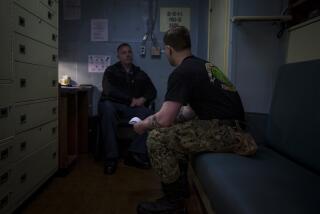Mission to Build Hope : 124 Seabees Will Help Marines in Somalia
- Share via
Just a smidgen over 5 feet tall, Navy Seabee Jana Edge nevertheless waslong on confidence that she will be up to the challenge in Somalia.
The 19-year-old and 123 other Seabees from Amphibious Construction Battalion 1 were standing in formation Tuesday on a grassy parade field near North Island Naval Air Station. Wearing Kevlar helmets, combat gear and carrying M-16 assault rifles, they waited for orders to board Air Force C-5 transports that would fly them to Somalia.
“It’s our job. It’s what Seabees do very well,” said Edge, an 11-month veteran and heavy equipment operator. “Our mission is to go over there and help those poor people. We’re in the military, and we don’t have the option of choosing our missions.”
Edge’s battalion, Assault Craft Unit 1 and Beachmaster Unit 1--making up Naval Beach Group One--will clear the way for main Marine battle units at Somalian ports. Many of the Seabees, who are stationed at Naval Amphibious Base at Coronado, are veterans of the Persian Gulf War.
Capt. Tom Fitzgibbons, commander of Naval Beach Group One, said the Seabees’ job will be to prepare the ports and help unload the ships “scheduled to arrive in Somalia in a few days” of Marines and their combat equipment.
The Seabees, short for construction battalions, learned of their departure schedule Monday night.
The somber troops waited in the early morning chill Tuesday and expressed disappointment over being away from home during Christmas. But, to a sailor, they were motivated by their humanitarian mission.
“When you see the broadcasts, you feel for the Somalians,” said Jean Pierre Shackelford, 21, of Columbus, Ohio. “You can’t just stand by. We have to do something. I feel real proud to be part of this mission.”
“You’re never thrilled about leaving during Christmas. But this mission is one that makes you feel good,” Fitzgibbons said.
The troops had been instructed to say goodby to their loved ones Monday night. However, several Seabee wives had been through the ritual in 1991, when their husbands left for Operation Desert Storm.
On Tuesday, not even a battalion of Marines could have kept some wives away from the parade field. Keeping a safe distance from the assembled Seabees, the women exchanged nervous glances with their husbands.
Shackelford’s wife, Camille, 22, and the couple’s 22-month-old daughter, Raven, waited patiently in the background, waiting for him to lift the baby into his arms one last time before he left.
“I know they need him, but we need him too,” said a tearful Camille Shackelford.
At least 10 of the approximately 124 Seabees deploying for Somalia were women. Edge, a native of Yerington, Nev., and the other women symbolized both the new look of the Seabees and their traditional “can do” motto.
Unlike their World War II predecessors, today’s Seabees battalions are integrated by gender. But like their predecessors, they are trained to fight as infantry units if necessary.
Asked why a woman would enlist in a Navy construction battalion, Edge responded politely, but firmly:
“I’m not a pencil pusher, sir. I wanted to do something constructive, because I’m a real sturdy girl. I’m a Seabee, sir.”
U.S. troops headed for Somalia have been issued desert camouflage uniforms, but the Seabees will follow tradition and wear “Seabee-green.”
“Seabees wear this uniform all over the world. A lot of people associate Seabee-green with help,” said Cmdr. Chuck Navin, leader of Amphibious Construction Battalion 1.
A few minutes before 9 a.m., the Seabees began loading their personal gear on trucks and boarded buses for the ride to North Island Naval Air Station, and two giant transport planes that would fly them and their construction equipment to Somalia.
But “hurry up and wait” was the operative military axiom. When the troops arrived at the air base, they were told that the Air Force couldn’t dispatch the planes.
The men and women learned they would be spending the night on cots inside a helicopter hangar and fly out today about 6:45 a.m. They were not allowed to visit with their loved ones.
“I kind of figured this would happen,” Petty Officer Carl Stanford said. “They tell us where to go, what to do. We do it. That’s it.”
There was one bright note for the grounded Seabees. A Coronado pizza restaurant learned the troops were going to be fed MRE rations--meals ready to eat--and donated 30 pizzas.
More to Read
Sign up for Essential California
The most important California stories and recommendations in your inbox every morning.
You may occasionally receive promotional content from the Los Angeles Times.













